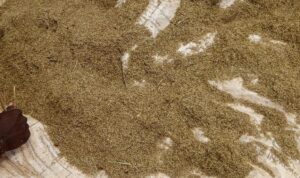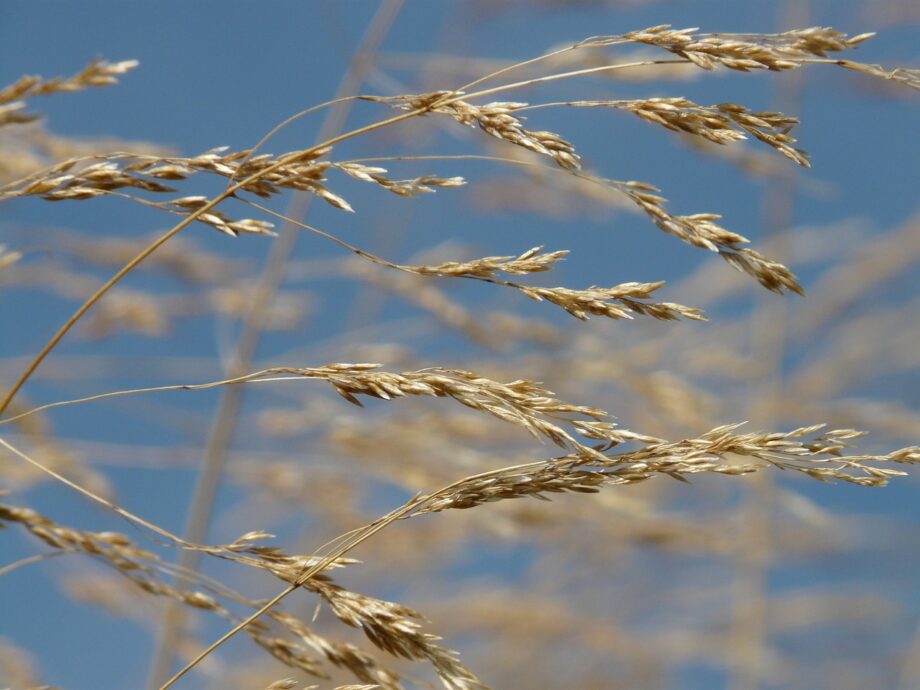Boma Rhodes grass (Chloris gayana) is a popular tropical grass species that are commonly used for grazing and hay production in many parts of Kenya.
It is a fast-growing, perennial grass that can reach up to 2 meters in height, and it has a high yield potential and good nutritional value for livestock.
Boma Rhodes grass is tolerant to a wide range of soils and can grow well in both dry and wet conditions.
It is also known for its ability to withstand heavy grazing and trampling, making it a popular choice for pasture management in intensive livestock production systems.
Overall, Boma Rhodes grass is a versatile and valuable forage species that can contribute to the productivity and sustainability of livestock production systems in Kenya and many parts of the world.
Boma Rhodes Grass Seeds
Boma Rhodes grass (Chloris gayana) seeds are commercially available and can be purchased from various seed companies and agricultural supply stores. The seeds are usually sold in bulk quantities and are suitable for planting in tropical and subtropical regions.

When purchasing Boma Rhodes grass seeds, it is important to ensure that the seeds are of high quality and have been properly tested and certified. This will help to ensure that the seeds have a high germination rate and will produce healthy and vigorous plants.
Before planting Boma Rhodes grass seeds, it is important to prepare the soil properly and ensure that it is well-drained and free of weeds and other debris. The seeds should be sown at a depth of 1-2 cm and spaced out evenly to allow for optimal growth and development.
It is also important to provide adequate water and fertilizer to the plants during the growing season to ensure that they reach their full potential. With proper care and management, Boma Rhodes grass can provide a reliable and high-quality source of forage for livestock production systems.
Nutrition Facts
Boma Rhodes grass is a highly nutritious forage species that are commonly used for grazing and hay production.
Here are some nutrition facts about Boma Rhodes grass;
- Boma Rhodes grass has a high dry matter content, which means that it is relatively low in moisture and has a high concentration of nutrients per unit of weight.
- It is rich in protein, with a crude protein content that can range from 8% to 18%, depending on the stage of growth and the management practices used.
- Boma Rhodes grass is also a good source of energy, with a high digestibility and metabolizable energy content that can support high levels of animal productivity.
- Rich in minerals such as calcium, phosphorus, potassium, and magnesium, which are important for animal health and productivity.
- Is a good source of Vitamins such as beta-carotene, vitamin E, and vitamin C, which are important for immune function and overall animal health.
Overall, Boma Rhodes grass is a highly nutritious forage species that can provide a valuable source of food for livestock and support high levels of animal productivity in tropical and subtropical regions.
Boma Rhodes Seeds Prices In Kenya
The price of Boma Rhodes grass seed in Kenya can vary depending on the quantity and quality of the seed, as well as the supplier and location. Typically, the price of Boma Rhodes grass seed ranges from Ksh. 200 to Ksh. 400 per kilogram.
Some factors that can affect the price of Boma Rhodes grass seed in Kenya include:
Seed quality: High-quality seeds that have been tested and certified can command a higher price than lower-quality seeds.
Quantity: Buying in bulk quantities can often result in a lower per-kilogram price.
Location: Prices may vary depending on the region and availability of the seed.
Supplier: Different suppliers may offer different prices depending on their overhead costs and profit margins.
It is important to compare prices and quality from different suppliers to ensure that you are getting the best value for your money. It is also important to ensure that the seed you purchase is of high quality and has been properly tested and certified to ensure optimal germination and growth.
Boma Rhodes Grass Yield Per Acre
The yield of Boma Rhodes grass can vary depending on several factors, including soil fertility, climate, rainfall, management practices, and the age of the stand.

Under optimal growing conditions, Boma Rhodes grass has the potential to yield up to 20 tons of dry matter per hectare per year (approximately 8.1 tons per acre).
However, it is important to note that actual yields can vary widely depending on the specific growing conditions and management practices used.
To achieve high yields, it is important to ensure that the soil is properly prepared and fertilized and that the plants are managed properly throughout the growing season.
Factors that can help to increase Boma Rhodes grass yield include:
Adequate soil fertility: Boma Rhodes grass responds well to fertilization with nitrogen, phosphorus, and potassium, as well as other micronutrients.
Good moisture management: Boma Rhodes grass requires regular and adequate water to grow well, and proper irrigation or rainfall management can help to optimize yields.
Proper grazing management: Grazing management practices that promote vigorous regrowth and avoid overgrazing can help to maintain high yields over time.
Overall, Boma Rhodes grass has the potential to provide high yields of nutritious forage for livestock production systems, and with proper management and care, it can be a valuable component of a sustainable farming system.
How To Plant Boma Rhodes Grass In Kenya
Here are the steps to plant Boma Rhodes grass in Kenya:
Site selection: Choose a site that is well-drained and receives adequate sunlight. Boma Rhodes grass grows best in fertile soils with a pH range of 5.5-7.5.
Land preparation: Clear the site of any debris and weeds. Plow or till the soil to a depth of 15-20 cm and allow it to dry for a few days. After drying, harrow or level the soil to create a fine seedbed.
Seed selection: Select high-quality Boma Rhodes grass seeds that have been tested and certified.
Seeding: Broadcast the seeds evenly over the prepared seedbed at a rate of 3-5 kg per acre. Lightly rake the soil to cover the seeds with a thin layer of soil.
Watering: Water the newly planted seeds immediately after planting and continue to water regularly to ensure germination and establishment.
Fertilization: Apply a basal fertilizer before planting to provide essential nutrients for growth. A recommended rate is 200-400 kg per acre of a complete fertilizer with a ratio of 20:10:10.
Weed control: Control weeds by hand or using herbicides. Weeds can be a major competition for young seedlings.
Grazing management: Allow the seedlings to grow to a height of 60-80 cm before grazing or cutting to promote good root development. Allow 30-45 days for regrowth before grazing again.
Overall, with proper care, Boma Rhodes grass can provide high yields of nutritious forage for livestock production systems.
How Long Does Boma Rhodes Take To Germinate
Boma Rhodes grass typically takes between 7 and 14 days to germinate under optimal conditions. However, germination time can vary depending on several factors, including temperature, moisture, soil type, and seed quality.

For best results, Boma Rhodes grass seeds should be planted during the rainy season, when soil moisture levels are high and temperatures are warm. Planting depth should be shallow, no more than 1-2 cm deep, and the soil should be kept moist but not waterlogged during the germination period.
It is important to note that germination is just the first step in establishing a healthy stand of Boma Rhodes grass.
Proper management practices, including irrigation, fertilization, weed control, and grazing management, are necessary to ensure that the plants continue to grow and produce high yields of nutritious forage for livestock production systems.
How Many Kgs Per Acre?
Under optimal growing conditions, Rhodes grass has the potential to yield up to 20 tons of dry matter per hectare per year (approximately 8.1 tons per acre).
However, actual yields can vary widely depending on the specific growing conditions and management practices used. To achieve high yields,
How Many Bales Grass Per Acre?
The number of bales of Boma Rhodes grass per acre can vary depending on several factors, including the yield per acre, the size of the bales, and the dry matter content of the forage.
Assuming a yield of 10 tons of dry matter per acre, and a bale size of 50 pounds (22.7 kg), the number of bales per acre would be approximately 882.
It is also important to consider the nutritional value of the Boma Rhodes grass, as this can affect the amount of forage needed to meet the requirements of livestock.
Boma Rhodes grass is a high-quality forage that is rich in protein and other nutrients and can provide a valuable source of feed for grazing animals.




